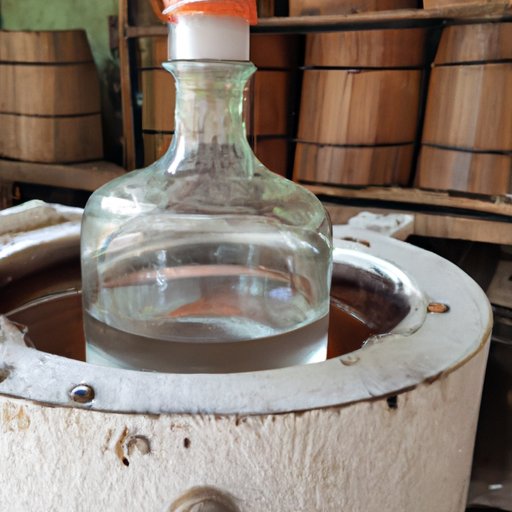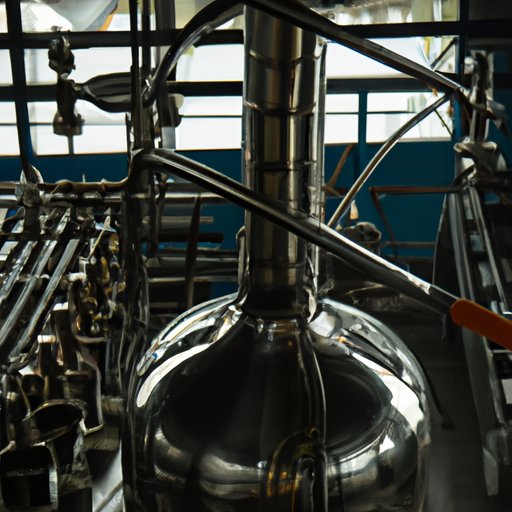Introduction
Distillation is a process used to separate liquids from solids or create a concentrated form of a liquid. It is an ancient technique that has been used for centuries to create a variety of products, including essential oils, perfumes, and most notably, alcoholic beverages. In this article, we will explore how does a distillery work and the process of making whisky, vodka & other spirits.

The Benefits of Distilling Spirits
Distilling spirits can be a complex process, but the rewards are well worth the effort. By distilling spirits, you can create unique flavors and aromas that can’t be replicated any other way. The process also allows for precise control over the strength and proof of the spirit, giving you the ability to craft your own signature blends. Finally, distilling your own spirits can save you money as you won’t have to pay for expensive store-bought brands.
A Step-by-Step Guide to Distilling Spirits
The science behind distillation is quite simple. When heated, the alcohol vaporizes faster than water and rises above the liquid. This vapor is then cooled, condensing the alcohol back into liquid form. The condensed liquid is then collected, creating a concentrated form of the alcohol.
To begin the distillation process, the liquid must first be heated. This is typically done by heating the liquid in a still, which is a large vessel designed specifically for distillation. The still is usually made of copper, which serves to increase the rate at which the alcohol vaporizes, as well as to help remove impurities from the liquid.
Once the liquid has been heated, the vaporized alcohol is then collected and cooled. This is typically done by passing the vapor through a series of tubes, known as a condenser. The condenser cools the vapor, causing it to condense back into liquid form. The condensed liquid is then collected and stored in a separate vessel.
The equipment used in the distillation process can vary depending on the type of spirit being produced. For example, whisky is typically distilled in a pot still, while vodka and other clear spirits are often distilled in a column still. Both types of stills use the same basic principles, but they differ in their design and in the amount of time it takes to complete the distillation process.
The Art of Crafting Quality Spirits: A Look Inside a Distillery
Crafting quality spirits requires more than just the distillation process. An experienced distiller must understand the art of blending different ingredients to create a unique flavor profile. They must also understand the importance of aging, as this can greatly influence the flavor of the finished product.
When crafting quality spirits, distillers must take into account the type of grains they are using, as well as the amount and type of yeast used in fermentation. The distillation process itself also plays an important role in determining the final product. Different stills produce different results, so it is important to understand the nuances of each type of still.
In addition to the distillation process, there are several other processes involved in producing high-quality spirits. These include filtration, dilution, and maturation. Once the spirit has been distilled and filtered, it is typically diluted with water to reduce its alcohol content. The spirit is then aged in oak barrels for a period of time, allowing the flavors to develop and mature.
The Process of Making Whisky, Vodka & Other Spirits
The process of making whisky, vodka and other spirits involves several distinct steps. The first step is to ferment the grain, which is typically done by adding yeast to the mash. The resulting liquid, known as “wash”, is then heated in a still to vaporize the alcohol. The vapor is then cooled and condensed back into liquid form, creating a concentrated form of the alcohol.
Depending on the type of spirit being produced, the distillation process may vary slightly. For example, whisky is typically distilled twice in a pot still, while vodka is usually distilled three or four times in a column still. This helps to create a smoother, cleaner spirit.
Once the spirit has been distilled, it is then filtered and diluted with water to reduce its alcohol content. Finally, the spirit is aged in oak barrels for a period of time, allowing the flavors to develop and mature. This is what gives whisky and other spirits their unique flavor profiles.
Conclusion
Distilling spirits is a complex process that requires skill and precision. The science behind distillation is fairly simple, but the art of crafting quality spirits is a delicate balance of ingredients and processes. By understanding the various steps involved in the distillation process, you can create your own unique blends of whisky, vodka & other spirits.
Whether you’re looking to make your own spirits or just want to learn more about the distillation process, understanding how does a distillery work and the steps involved in producing quality spirits is essential. With some practice and patience, you can create your own unique blends and enjoy the fruits of your labor.
(Note: Is this article not meeting your expectations? Do you have knowledge or insights to share? Unlock new opportunities and expand your reach by joining our authors team. Click Registration to join us and share your expertise with our readers.)
